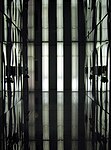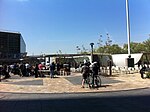Museum of Jewish Heritage

The Museum of Jewish Heritage, located in Battery Park City in Manhattan, New York City, is a living memorial to those murdered in the Holocaust. The museum has received more than 2 million visitors since opening in 1997. The mission statement of the museum is "to educate people of all ages and backgrounds about the broad tapestry of Jewish life in the 20th and 21st centuries — before, during, and after the Holocaust."The museum's building includes two wings: a six-sided building with a pyramid-shaped roof designed to evoke the memory of the six million Jews killed in the Holocaust, and the Robert M. Morgenthau Wing. The six-sided building, opened in 1997, contains the museum's core exhibition galleries. The Morgenthau Wing, opened in 2003, contains the museum's offices, theater, and classrooms, as well as the Irving Schneider and Family exhibition gallery. Both wings were designed by designed by Roche-Dinkeloo.
Excerpt from the Wikipedia article Museum of Jewish Heritage (License: CC BY-SA 3.0, Authors, Images).Museum of Jewish Heritage
Battery Park City Greenway, New York Manhattan
Geographical coordinates (GPS) Address Website External links Nearby Places Show on map
Geographical coordinates (GPS)
| Latitude | Longitude |
|---|---|
| N 40.706211 ° | E -74.01875 ° |
Address
Museum of Jewish Heritage
Battery Park City Greenway
10280 New York, Manhattan
New York, United States
Open on Google Maps







